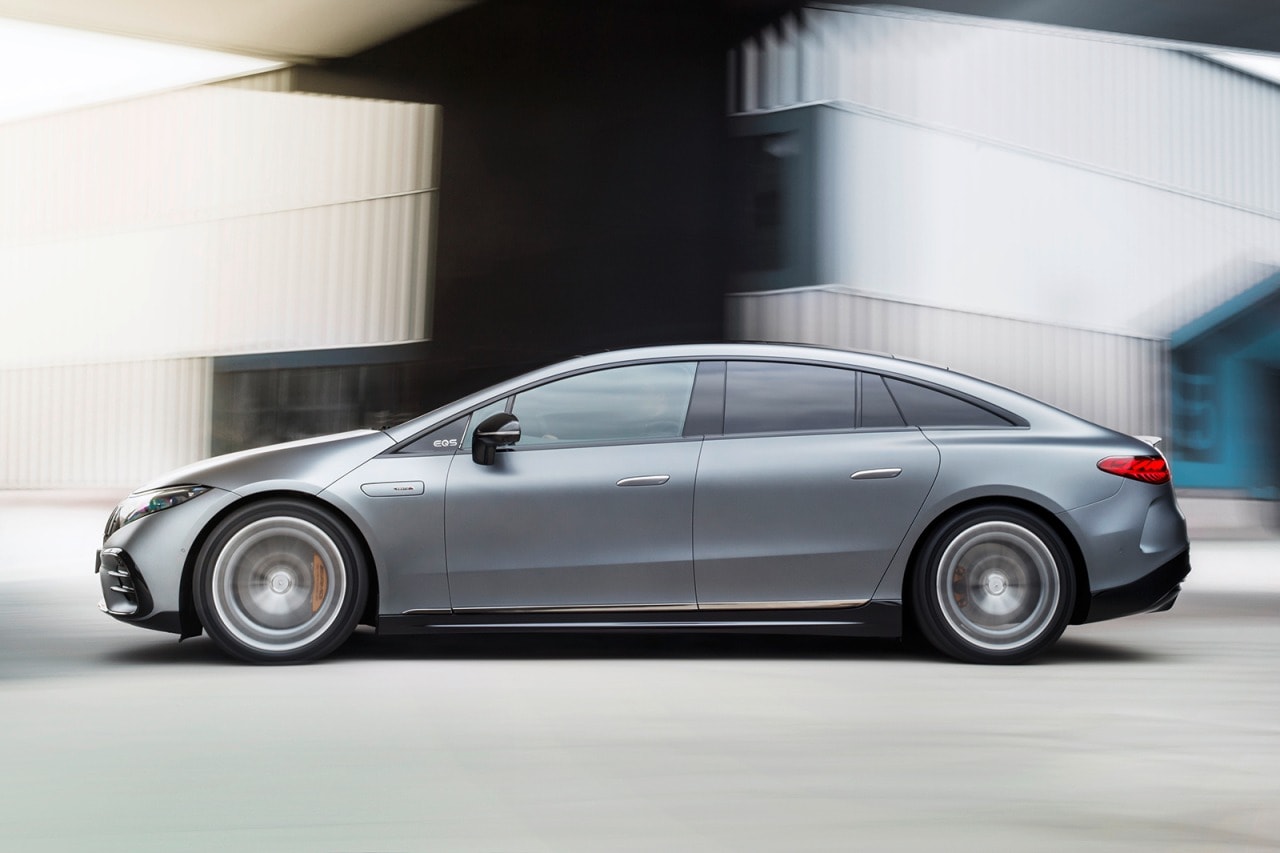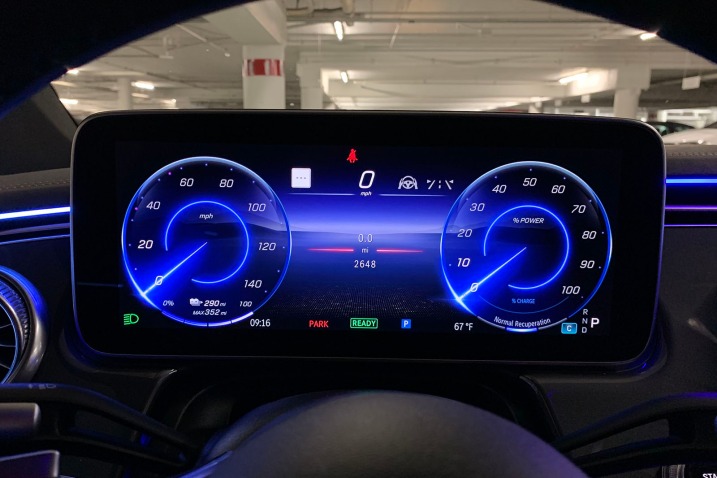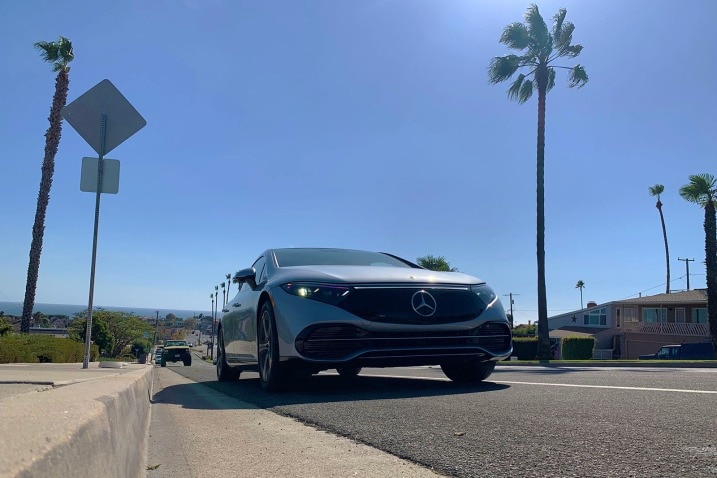- The 2022 Mercedes-Benz EQS 450+ covered 422 miles on Edmunds' real-world EV range loop, blasting past its EPA-estimated range of 350 miles.
- The EQS 450+ is Edmunds' new real-world EV range leader by 77 miles.
- Recharging the EQS's sizable 108-kWh battery pack took about 20 hours on our Level 2 charger.
TESTED: 2022 Mercedes-Benz EQS Sets New Edmunds EV Range Record
The previous leaders are now 77 miles behind
The 2022 Mercedes-Benz EQS is not the first electric vehicle from Mercedes-Benz. That honor belongs to the 1906 Mercedes Electrique. But the EQS is definitely the brand's latest EV, and although we've never range-tested an Electrique, we imagine the EQS is a bit more efficient.
Roughly the size of an S-Class, the EQS is M-B's electric flagship, ushering in a new generation of gas-free models. For this test, we got our hands on an EQS 450+, which comes standard with a single electric motor driving the rear wheels to the tune of 329 horsepower and 419 lb-ft of torque. It's fed by a lithium-ion battery pack with a usable capacity of 107.8 kilowatt-hours — and the EPA says it's capable of traveling 350 miles on a single charge.
But how would the EQS 450+ perform on our real-world EV range loop? We were quite interested to find out.
Am I Ready for an EV?
- EV ownership works best if you can charge (240V) at home or at work This typically means a 240V home installation, but you could also have a similar setup at your office or other places your car is already parked for several hours each day. Don't expect a regular household outlet (120V) to suffice unless you've got a plug-in hybrid, in which case overnight charging at home is feasible.
- If you can’t charge at home, charging at a charging station could take at least 10x longer than at a gas station With public charging infrastructure still in its infancy, the user experience can be maddeningly inconsistent. Tesla owners tend to rave about the reliability and speed of the company's proprietary Supercharger stations, but rival DC fast options have thus far been plagued by technical issues and overcrowding. It's an evolving landscape and our best advice is to do your research on the available options for the EV you want to buy.
- Adding a 240V home charging system could cost up to $1,600 or more If your existing electrical service can handle the additional demands of EV charging, you may be able to add Level 2 charging at home for less than a grand, including installation. But your costs will multiply if you need to upgrade your electrical panel or add a dedicated circuit.
2022 Mercedes-Benz EQS
Testing the Mercedes-Benz EQS 450+ in the real world
Edmunds tests every new electric vehicle on the same real-world driving loop to see just how far it can travel from a full charge down to zero miles remaining. If you scroll through our EV range leaderboard, you'll see that most EVs have matched or exceeded their EPA range estimates in our testing. Much of that has to do with our ability to test in near-ideal conditions year-round.
Our EQS 450+ test car was surprisingly light on options. Options can add weight and sometimes introduce additional types of inefficiencies, so this particular EQS was primed for our test. It was equipped with the standard 20-inch wheels with "range-optimized summer tires" (Goodyear Eagle F1 Asymmetric 5, 255/45 R20) at all four corners, inflated to the factory-recommended pressure of 41 psi. Our test car weighed in at 5,500 pounds on the nose, which is exceptionally heavy for a sedan — to put that figure in context, the last S-Class we tested weighed in at 5,069 pounds.
Over the course of a lengthy 12-hour stint in the EQS 450+ at an average temperature of 67 degrees, we managed to travel a total of 422 cheek-numbing miles. That's 72 miles more than the EPA estimate, an improvement of more than 20%. This stunning performance lands the EQS 450+ in first place on our leaderboard, and not by a whisker. The previous leaders from Tesla now trail the Benz by a whopping 77 miles.
So how much did those 422 miles cost?
While the total range of a vehicle continues to dominate the EV conversation and will likely be a popular talking point for the EQS, energy consumption is an important factor as well. Energy consumption is what determines how much your miles will cost you. The unit of measurement for consumption, the kilowatt-hour, can be thought of as the EV equivalent of a gallon of gasoline. Just like gas, the price of electricityvaries depending on where you live. For example, you'll pay about 10 cents per kilowatt-hour in Washington as of this writing, whereas in Hawaii it'll run you about 33 cents.
So, what can 2022 Mercedes-Benz owners expect to pay at "the pump"? After charging the battery back to full, which took about 20 hours on our Level 2 charger, we calculated an Edmunds consumption rate of 29.5 kWh/100 miles, which is 15.7% more efficient than the EPA estimate of 35 kWh/100 miles. If we lived in Hawaii, our 422-mile trip in the EQS would have cost us $41.08, while if we lived in Washington, that same trip would cost just $12.45.
If we compare the EQS to a similarly sized EV we drove recently, the far more powerful tri-motor Tesla Model S Plaid, the same 422 miles would have cost $44.70 in Hawaii and $13.55 in Washington. It's mighty impressive that the quickest vehicle Edmunds has ever tested only costs another dollar or three per charge than the relatively sedate EQS, although to be fair, the Plaid starts at about $25,000 more.
2022 Mercedes-Benz EQS
How about a gasoline-powered equivalent? Well, since the EQS is essentially an electric S-Class, we figured we'd compare it against the latest version of that venerable model. The S 500 is powered by a thoroughly modern inline-six that's both supercharged and turbocharged and employs a 48-volt mild hybrid system. It requires premium fuel and is estimated to return a respectable 24 mpg in combined driving. Driving it for 422 miles would have set us back $84.40 in Hawaii ($4.80 per gallon) and $74.91 in Washington ($4.26 per gallon) at current prices, assuming we got the S 500's combined mpg.
Based on these numbers, you could save an estimated $1,026 per year in Hawaii and around $1,490 per year in Washington by driving an EQS 450+ for 10,000 miles a year instead of the S 500. The S 500 does enjoy a slight speed advantage, though, what with 429 horsepower and 384 lb-ft of torque at its disposal. And any S-Class has far more accommodating rear cabin seating.
For more information on how we test EV range and how each vehicle performed, we invite you to visit our Real World vs. EPA testing page, which includes both our EV range leaderboard and a table with detailed test results. Our EV range leaderboard is embeddable and will automatically update every time we add a new vehicle.
Edmunds says
The 2022 Mercedes-Benz EQS overdelivers when it comes to range and efficiency, which is a positive sign for Mercedes-Benz's new EV portfolio. We're looking forward to comparing different specifications of EQS models to get a clear picture of range and efficiency across the board. For our latest comprehensive ratings of all electric vehicles, head over to Edmunds' EV rankings page.



 by
by